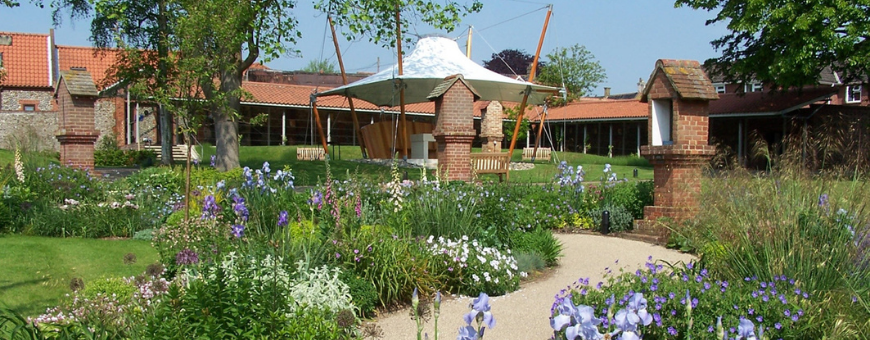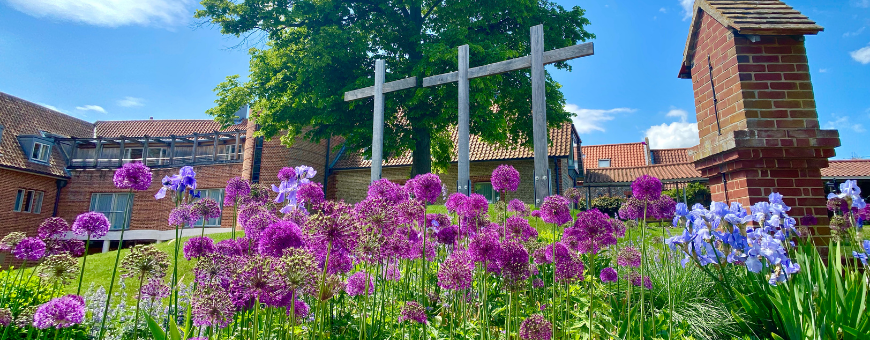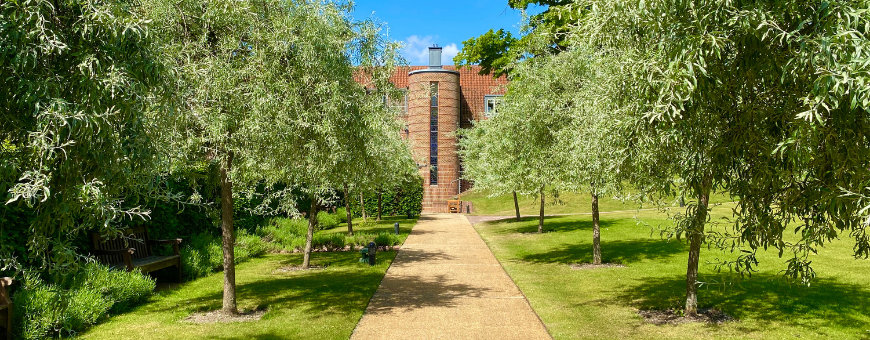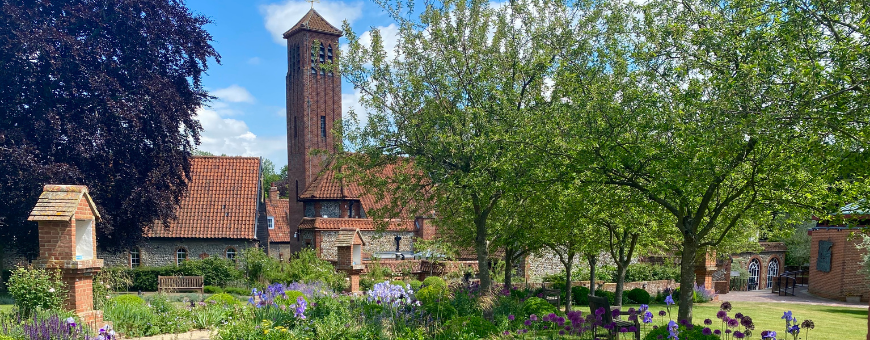Opening Times
THE GARDENS of the Shrine of Our Lady of Walsingham have always played an important part in the pilgrimage programme whether for processions of Our Lady or the Blessed Sacrament, for outdoor services using the garden altar, or as a quiet space for meditation and reflection.
The gardens were originally laid out in the 1930’s and developed as the Shrine Church grew in size and the number of pilgrims increased. By the year 2000 much of the original planting and planning had been lost - hedges which had been intended to be knee-height were now well over six foot. Vistas had become obscured and much of the planting had become haphazard and stop-gap.
In 2004 the Guardians approved the garden scheme you see today, which was designed by Tessa Hobbs. Her brief was to make the space more open and dynamic, to create a garden which drew pilgrims and visitors into the Shrine, rather than turning them away with high hedges and paths leading nowhere. Colour and smell was to play a crucial part in the overall planting and changing levels would add dynamism. Thrown into the mix was the need to anticipate the landscape needs of the new building, The Milner Wing, to provide an effective processional route and to provide seating areas.
The Main Garden
Work started on the Main Garden in November 2004 and was finished by early summer 2005. The Calvary (with the three crosses) was retained but dramatically ‘heightened’ by dropping the levels all around it. Many tons of earth were shifted and apart from the Calvary the only things that remained in place were the Stations of the Cross. Lawns bordered with lavender and roses are bisected by the Serpentine Path with its flanking beds of a constantly moving drift of flowers and grasses – in gentle shades ranging through the spectrum from soft greens and whites through yellows, blues, purples and pinks to magenta.
The Pool Garden, adjacent to the Shrine Church was constructed at the same time. The intention was to create an area of calm - the splash of water, the scent of roses and lavender - for pilgrims before they visit the Holy House.
In front of Stella Maris House a medieval style Physic Garden was created with woven willow edgings to the geometric beds which were filled with herbs. Alas, being north facing, there was a lack of sun and so this area has been adapted as a outdoor sitting area with formal box edged beds filled with Rosa gallica ‘Versicolor and Rosa gallica, both known as the ‘Apothecary’s rose. They only flower once but are well worth it when they do!
The Quiet Garden - which is entered through the Shrine Church - was constructed in 2006. This area, containing Stations of the Cross 1 and 2 had long been neglected. Indeed the southern part was more like a waste land! Here another pool was created containing water plants and sunny seating.
The Serpentine Path
The Serpentine Path has become a much loved feature of the Shrine gardens in a very short time. Regular visitors are amazed at the way the flowering imperceptibly shades from spring to summer, to autumn, then winter. There is never a dull or uninteresting moment. Spring hyacinths and tulips followed by irises give way to grasses and euphorbia, followed by daisies, oregano and lilies, campanula and Japanese anemones and agapanthus – to name but a few - a constant glimmer of colour, scent and movement. When used for processions the path adds a new dimension to singing by candlelight - and enables groups of pilgrims to see and smile at each other as they wend their way around the curves.
Several different varieties of small Trees were planted including a crab-apples - Malus hupehensis (west side of the serpentine path) and weeping pears – Pyrus salicifolia ‘Pendula’ (along the straight path by Stella Maris, olive trees (Olea Europea (by the circular pond) and ornamental pears (Pyrus calleryana 'Beech Hill') by St Anne’s House. At the West Front of the Shrine Church there are two Acer palmatum trees with an underplanting of Picea abies ‘Nidiformis’, Ceratostigma wilmottianum, Eryngium tricuspidata, Bergenia and Helichtotrichon sempervirens. The stones are Paddle Stones from northern England.
The Rockery which runs alongside the sunken path by the Shrine Church Sacristy is planted with Viburnum carlesii, Potentilla vilmorinii, Hebe pagei, Sarcococca confusa (very scented in the early months of the year) and Philadelphus erectus.
The Garden Altar
In 2005 ‘The Altar of the Mysteries of Light’ was erected on an upper lawn of the garden to replace the original ‘Halifax Altar’ which had been demolished at the time of the 2004 garden renovation. It had been found to be critically unsafe when given a slight experimental nudge with a digger and collapsed into a sorry heap without any further encouragement! The new altar, representing ‘Pilgrimage’ in its tented shape, and so suggesting onward travel is a wonderful and dramatic adjunct to the outdoor worship.
The Milner Wing was completed over 2007-2008 and pilgrims would now have to think quite hard as to how and where they were greeted and dispersed around the Shrine in the ‘old days’! It has revolutionised the flexibility of the room allocation in particular for those requiring ease of access or other needs.
The Cafe-Bar Area
During the early spring of 2017 the area now known as ‘Norton’s Courtyard’ has enhanced the space outside Norton’s, which itself was upgraded in around 2010. It is a popular place to stop off and chat, and have a meal, for pilgrims and outsiders alike. The access has been greatly improved for wheelchairs and walkers. Quince trees and Olive trees planted in raised beds with wooden seating add to its charm.
Over the last few years many improvements have been made to the buildings behind the scenes, largely for the use of clergy . The old College accommodation was almost entirely rebuilt and now resembles a cloister, but with smart ensuite bedrooms. St Augustine’s, which was direly in need of the restoration which it received, houses a library for study purposes and study bedrooms.
All in all in this century alone the physical Shrine has been transformed into a thoroughly modern working machine catering for pilgrim needs in a way that would have been unthinkable 50 years ago but is now expected by the modern traveller.
Bishop Martin Warner started the ball rolling at the turn of the century with the hugely ambitious design and execution of the ‘New’ refectory. It's innovative and exciting concept set a standard of excellence for his successors to aspire to!
Just take a good look at it, the tower and the curving colonnade and the beautiful brickwork, not to mention the engraving and wonderful stained glass. Then enjoy your dinner!



